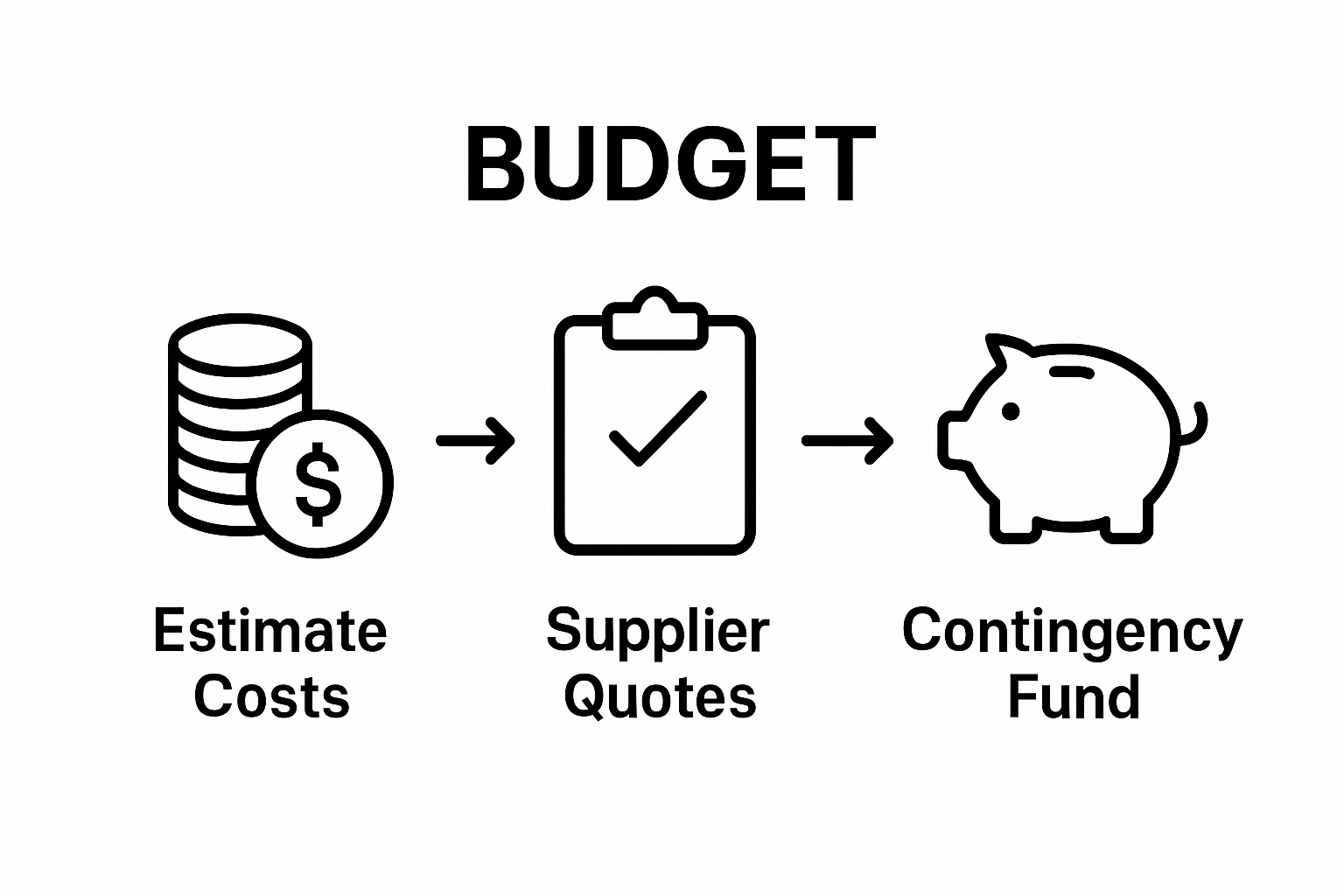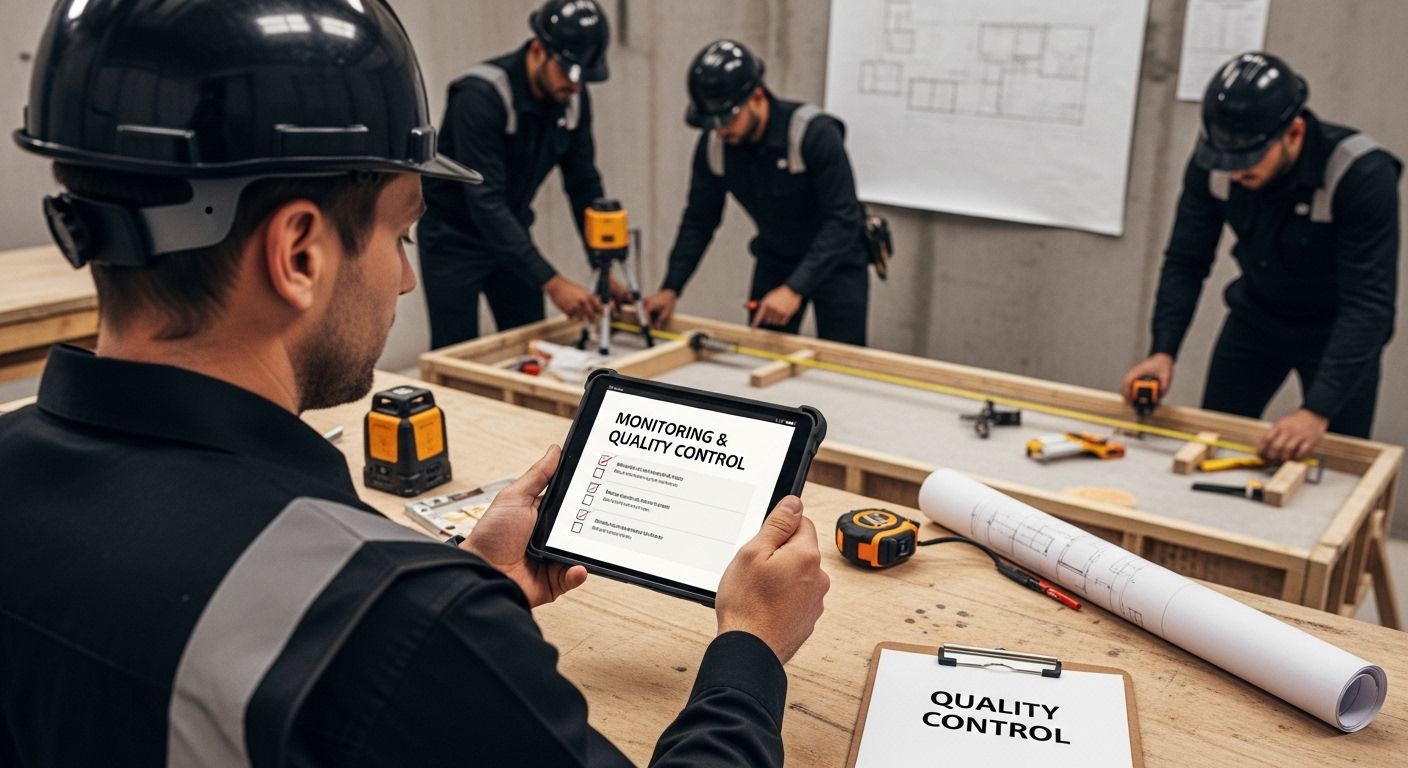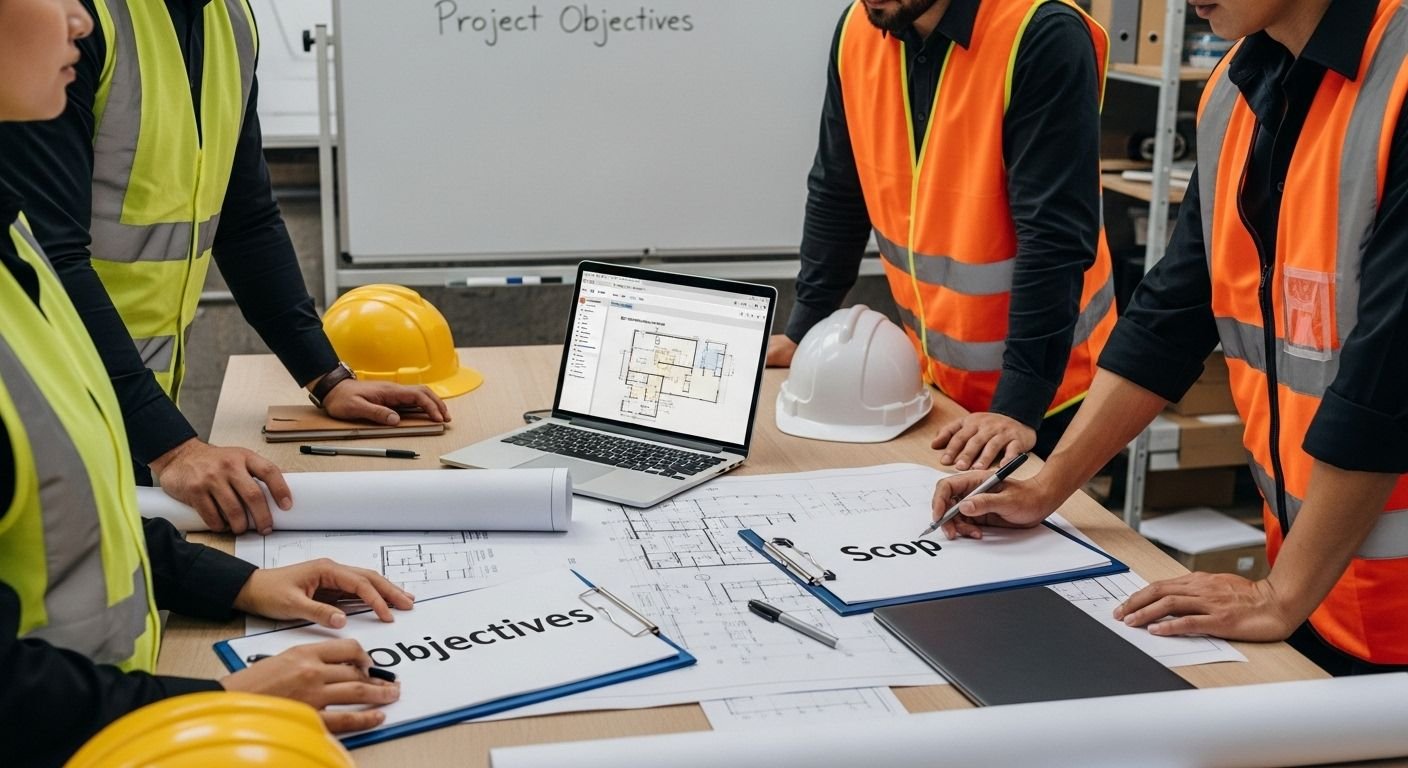Every construction project promises a unique mix of ambition and complexity, with success measured in meeting deadlines, sticking to budget, and delivering quality that stands the test of time. Yet, even with the latest technology and skilled teams at hand, only about 31 percent of construction projects come in on time and within budget. Most people assume more resources or bigger teams are the answer, but the real secret lies in how well you plan before a single brick is laid.
Table of Contents
- Step 1: Define Project Objectives And Scope
- Step 2: Establish A Realistic Timeline
- Step 3: Create A Detailed Budget
- Step 4: Assemble Your Project Team
- Step 5: Develop A Risk Management Strategy
- Step 6: Implement Monitoring And Quality Control
Quick Summary
| Key Point | Explanation |
|---|---|
| 1. Define Clear Project Objectives | Establish precise objectives to guide planning and execution, capturing stakeholder visions and requirements carefully. |
| 2. Develop a Realistic Timeline | Create a dynamic schedule with manageable milestones, incorporating all variables to accommodate potential delays and challenges. |
| 3. Assemble a Strong Project Team | Curate a skilled team with complementary capabilities to ensure effective collaboration and problem-solving throughout the project. |
| 4. Implement Comprehensive Risk Management | Identify potential risks early and develop targeted mitigation strategies to safeguard project objectives and manage uncertainties. |
| 5. Establish Robust Monitoring and Quality Control | Set up performance tracking metrics and regular reporting mechanisms to ensure adherence to standards and facilitate immediate corrective actions. |
Step 1: Define Project Objectives and Scope
Defining clear project objectives and scope forms the critical foundation for successful construction project planning. This initial step determines the entire trajectory of your project, establishing precise boundaries, expectations, and deliverables that will guide all subsequent planning and execution stages.
Beginning with comprehensive objective setting requires deep analysis of project requirements, stakeholder expectations, and practical constraints. You must develop a crystal clear understanding of what the project aims to achieve, encompassing both broad strategic goals and specific technical specifications. This involves conducting thorough consultations with key stakeholders including clients, architects, engineers, and potential subcontractors to capture their vision and technical requirements.
Establishing Comprehensive Project Parameters
The scoping process demands meticulous attention to detail. You will need to document specific project parameters including physical dimensions, functional requirements, quality standards, budget limitations, and anticipated timeline. Creating a detailed project brief becomes your roadmap, outlining exact expectations that prevent potential misunderstandings or scope creep during later project stages.
Key elements to document comprehensively include project purpose, target outcomes, technical specifications, performance criteria, regulatory compliance requirements, and anticipated challenges. A robust scope definition helps mitigate risks by establishing clear boundaries and expectations from the project’s inception. By investing significant effort in this foundational step, you create a robust framework that supports efficient decision making, resource allocation, and project management throughout the construction process.
Verification and Documentation
Successful objective and scope definition requires thorough verification. Your project scope document should be reviewed and approved by all primary stakeholders, ensuring collective understanding and agreement. Look for these critical validation indicators:
- Clear, measurable project objectives
- Comprehensive technical specifications
- Agreed budget and timeline parameters
- Stakeholder sign off on project brief
- Identified potential constraints or challenges
Careful documentation during this stage transforms abstract concepts into concrete project blueprints, setting the stage for precise construction project planning steps that follow.
Below is a checklist table outlining the critical criteria for verifying the project scope and objectives, helping ensure robust early-stage planning and stakeholder agreement.
| Verification Criterion | Details |
|---|---|
| Clear, measurable project objectives | Objectives should be specific and assessable |
| Comprehensive technical specifications | All requirements and standards fully documented |
| Agreed budget and timeline parameters | Consensus on financial and scheduling expectations |
| Stakeholder sign off on project brief | Formal approval from all main project stakeholders |
| Identified potential constraints or challenges | Known risks or limitations clearly noted and evaluated |
Step 2: Establish a Realistic Timeline
Establishing a realistic timeline represents a critical phase in construction project planning steps, transforming your project objectives into a structured sequence of actionable milestones. This step bridges the gap between conceptual planning and practical execution, requiring strategic thinking and meticulous scheduling that accounts for complex interdependencies and potential challenges.
Creating an effective project timeline demands a comprehensive approach that goes beyond simple date tracking. You must develop a dynamic schedule that considers multiple variables including resource availability, potential weather disruptions, regulatory approval processes, material procurement timelines, and the intricate choreography of subcontractor activities. Successful timeline development requires a granular understanding of each project phase, breaking down complex processes into manageable segments with precise start and completion dates.
Strategic Timeline Development
Navigating timeline creation involves carefully mapping out each project stage with realistic time allocations. Begin by conducting a detailed task decomposition, where you break down the entire project into specific activities and estimate realistic durations for each. This process requires deep knowledge of construction methodologies, potential bottlenecks, and reasonable buffer times for unexpected complications.
According to research from University College London, both insufficient and excessive planning can compromise project performance. Your timeline should strike a delicate balance between ambitious targets and practical constraints. Engage with experienced team members and subcontractors to validate time estimates, leveraging their practical insights to refine your initial projections.
Timeline Verification Criteria
To ensure your timeline’s reliability, evaluate it against these critical verification indicators:
- Comprehensive task sequencing with logical dependencies
- Realistic time allocations for each project phase
- Incorporated buffer periods for potential delays
- Alignment with stakeholder expectations
- Consideration of external factors like seasonal constraints
A well-constructed timeline serves as a dynamic roadmap, providing clear guidance while remaining flexible enough to accommodate inevitable project complexities. By investing significant effort in this crucial planning stage, you establish a robust framework that supports efficient project management and increases the likelihood of successful, timely project completion.
This table summarises the key verification criteria for validating your construction project’s timeline, ensuring all essential elements are addressed for effective scheduling.
| Verification Criterion | Details |
|---|---|
| Logical task sequencing | Activities arranged with correct dependencies |
| Realistic time allocations | Timeframes based on informed estimates and practical experience |
| Buffer periods included | Adequate allowance for potential delays and unforeseen events |
| Stakeholder alignment | Timeline meets client and team expectations |
| Consideration of external factors | Seasonal, regulatory, or supply chain impacts assessed |
Step 3: Create a Detailed Budget
Creating a detailed budget represents a pivotal stage in construction project planning steps, transforming your project vision into a financially viable framework. This critical process demands precision, foresight, and comprehensive cost analysis that goes far beyond simple numerical calculations.
Developing a robust budget requires an intricate understanding of every potential financial component within your construction project. You must meticulously account for direct costs like materials, labour, equipment, and subcontractor fees, while simultaneously incorporating indirect expenses such as permits, insurance, site management, and potential contingency reserves. Effective budgeting is not about minimising expenses, but strategically allocating resources to maximise project value and performance.
Comprehensive Financial Planning
The budgeting process begins with granular cost estimation for each project phase. Start by breaking down your project into discrete cost categories, conducting thorough market research to understand current pricing dynamics for materials, labour, and specialised services. Engage with multiple suppliers and subcontractors to obtain competitive quotes, ensuring you have a comprehensive view of potential expenses.
According to the UK Government’s Cost Estimating Guidance, developing a transparent and robust budget requires careful consideration of both predictable and unpredictable financial variables. This means incorporating a realistic contingency fund typically ranging between 5% to 10% of the total project budget to manage unexpected challenges or market fluctuations.
Budget Verification Criteria
To validate the reliability and comprehensiveness of your budget, assess it against these critical indicators:
- Detailed line item breakdown of all anticipated expenses
- Sourced quotes from multiple suppliers and contractors
- Incorporated contingency and risk management funds
- Alignment with project timeline and scope
- Stakeholder review and approval
A meticulously crafted budget serves as more than a financial document it becomes a strategic tool that guides decision making, supports resource allocation, and provides a clear financial roadmap for successful project completion. By investing significant effort in this crucial planning stage, you establish financial transparency and control that minimises risks and maximises project potential.

Step 4: Assemble Your Project Team
Assembling the right project team represents a critical juncture in construction project planning steps, where strategic personnel selection can dramatically influence project success. This stage transforms your project from a conceptual blueprint into a living, collaborative endeavour by bringing together skilled professionals who will translate your vision into tangible results.
Building an exceptional project team requires far more than simply collecting skilled individuals. You must carefully curate a group of professionals whose expertise, communication styles, and collaborative capabilities align seamlessly with the project’s unique requirements. The ideal team functions as an integrated ecosystem, where each member’s strengths complement the collective capabilities, creating a synergistic environment that can navigate complex challenges and deliver outstanding outcomes.
Strategic Team Composition
Successful team assembly begins with comprehensive role definition, identifying the precise skills and expertise required across different project stages. Start by mapping out critical positions such as project manager, lead architect, structural engineer, quantity surveyor, site supervisor, and key subcontractor representatives. Consider not just technical competencies, but also interpersonal dynamics, communication skills, and proven track records of collaborative performance.
According to the UK Department for Education’s Construction Framework Handbook, effective team assembly goes beyond individual qualifications. You must evaluate potential team members based on their ability to work cohesively, adapt to evolving project demands, and maintain high standards of professional communication and problem solving.
Team Integration and Verification
To ensure your team’s effectiveness, assess its composition against these critical verification criteria:
- Comprehensive coverage of all required technical disciplines
- Demonstrated history of successful collaborative projects
- Clear understanding of individual and collective roles
- Complementary skill sets and communication styles
- Alignment with project budget and timeline constraints
A strategically assembled project team represents more than a collection of professionals it becomes the driving force that transforms your construction project planning from theoretical strategy into practical, successful execution. By investing significant effort in team selection, you create a robust foundation that supports innovation, efficiency, and exceptional project delivery.
Step 5: Develop a Risk Management Strategy
Developing a comprehensive risk management strategy represents a crucial phase in construction project planning steps, where proactive identification and mitigation of potential challenges can significantly impact project success. This strategic approach transforms uncertainty from a potential threat into a manageable aspect of project execution.
Risk management goes far beyond simple problem identification. You must create a dynamic, forward thinking framework that anticipates potential disruptions across technical, financial, operational, and environmental dimensions. Effective risk management is not about eliminating all risks, but understanding, quantifying, and developing targeted mitigation strategies that protect project objectives.
Systematic Risk Assessment
Beginning your risk management process requires a systematic and thorough approach to identifying potential project vulnerabilities. Start by conducting comprehensive workshops with your project team, encouraging open dialogue about potential challenges that could impact project timeline, budget, or quality. This collaborative exercise should explore risks across multiple domains including material supply chain disruptions, regulatory compliance challenges, weather related complications, labour availability, and technological uncertainties.
The risk assessment must move beyond theoretical speculation, demanding concrete probability and impact evaluations. For each identified risk, you will need to calculate potential financial implications, likelihood of occurrence, and develop specific contingency plans. This involves creating detailed risk registers that categorise potential challenges, assign ownership for monitoring and mitigation, and establish clear escalation protocols.
Risk Management Verification Criteria
To validate the robustness of your risk management strategy, assess it against these critical indicators:
- Comprehensive risk identification across all project domains
- Quantified probability and potential impact for each risk
- Clearly defined mitigation and contingency plans
- Assigned risk ownership and monitoring responsibilities
- Regular review and update mechanisms
A meticulously developed risk management strategy serves as a dynamic shield, protecting your project from potential disruptions while providing the team with a structured approach to navigating uncertainties. By investing significant effort in this critical planning stage, you establish a proactive framework that supports resilient and adaptable project management.
Step 6: Implement Monitoring and Quality Control
Implementing robust monitoring and quality control represents a pivotal stage in construction project planning steps, transforming theoretical guidelines into a systematic approach for maintaining exceptional standards throughout project execution. This critical phase ensures that every aspect of your project adheres to predefined specifications, budget constraints, and performance expectations.
Monitoring and quality control transcend simple oversight they represent a comprehensive framework for continuous assessment and improvement. Your approach must combine rigorous performance tracking with proactive intervention strategies, creating a dynamic system that identifies potential deviations before they escalate into significant challenges.
Comprehensive Performance Tracking
Establishing an effective monitoring system requires developing a multi layered approach that captures performance metrics across technical, financial, and operational dimensions. Begin by defining clear key performance indicators (KPIs) that provide granular insights into project progress. These indicators should encompass critical areas such as timeline adherence, budget utilisation, quality standards, safety compliance, and resource efficiency.
According to the UK Government’s Common Minimum Standards for Construction, effective monitoring demands consistent, structured reporting mechanisms. Implement regular site inspections, detailed progress reports, and structured review meetings that bring together key stakeholders to assess project performance. These sessions should not merely report status but facilitate collaborative problem solving and immediate corrective actions.
Quality Control Verification Criteria
To validate the effectiveness of your monitoring and quality control approach, assess it against these critical indicators:
- Comprehensive and regularly updated performance metrics
- Clear escalation protocols for addressing identified issues
- Consistent documentation of project progress and challenges
- Transparent communication channels across project teams
- Mechanisms for continuous improvement and learning
A meticulously implemented monitoring and quality control strategy serves as the project’s central nervous system, providing real time insights that enable agile decision making. By investing significant effort in developing a robust tracking framework, you create a proactive approach that supports exceptional project delivery and minimises potential risks.

Transform Your Project Planning into Real Results with Expert Cost Support
You have just read about the essential construction project planning steps needed for success, from defining robust objectives to addressing risk and quality control. Yet, the most common stumbling block for many professionals is translating this thorough planning into precise budgeting, reliable cost estimates, and winning financial strategies. You may know how critical detailed cost planning and transparent estimating are to avoid overruns, secure profitable outcomes, and protect your reputation. But without specialist support and up-to-date market insight, these vital steps can easily become a source of stress, confusion, or costly mistakes.
Ready to move beyond planning to confident action? Visit our Cost Planning and Cost Estimating sections to discover how our UK-based experts at My Project Estimating deliver accurate, tailored solutions for construction professionals across the industry. Upload your plans for a fast, transparent quote or explore our resources built specifically for contractors, developers, architects, and self-builders aiming to maximise profitability. Do not let uncertainty with budgeting derail your next project. Take the next step and secure the confidence that comes from data-driven, professional estimating support today.
Frequently Asked Questions
What are the key steps in construction project planning?
The essential steps in construction project planning include defining project objectives and scope, establishing a realistic timeline, creating a detailed budget, assembling your project team, developing a risk management strategy, and implementing monitoring and quality control.
How can I ensure my project’s timeline is realistic?
To establish a realistic timeline, break down the project into specific activities, estimate durations for each task, account for resource availability and potential delays, and incorporate buffer periods for unexpected complications. Engage experienced team members to validate these estimates.
What elements should be included in a construction project budget?
A comprehensive construction project budget should detail direct costs like materials, labour, and equipment, as well as indirect expenses such as permits, insurance, and site management. It’s essential to include a contingency fund to manage unforeseen challenges or market fluctuations.
How do I develop an effective risk management strategy for my construction project?
To develop an effective risk management strategy, identify potential risks through workshops with your team, assess their probability and impact, create a risk register to categorise and monitor risks, and establish contingency plans to address potential challenges.


